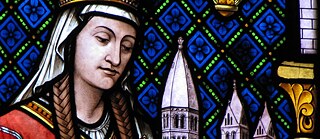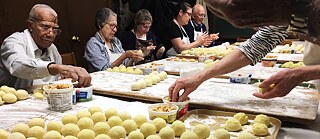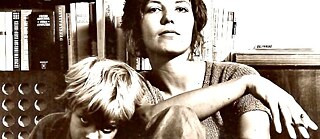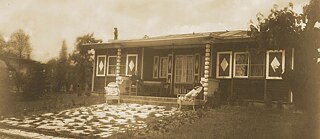Lebendiges Mittelalter
St. Hildegard of Bingen
Hildegard von Bingen war eine Nonne, die im 12. Jahrhundert in Deutschland lebte und auch als Autorin, Komponistin von Kirchenliedern, Mystikerin und Visionärin bekannt ist. Wie sich herausstellt, hat sie mit unserem heutigen Leben noch immer eine ganze Menge zu tun.
Diese Folge anhören: Apple Music | Spotify | Download
Diese Folge stammt von Katie Marquette. Katie ist eine unabhängige Radioproduzentin und Sounddesign-Beraterin. Für Baltimores NPR-Sender WYPR 88.1 produzierte sie zahlreiche lokale Shows und Podcasts. In diesem Podcast unterhält sich Katie Marquette mit Musikwissenschaftlerinnen und Student*innen, die sich mit Hildegard von Bingen beschäftigen, und mit Sarah Berger vom Peabody Conservatory in Baltimore, an dem heute noch mittelalterliche Musik und Gesänge gelehrt und aufgeführt werden. Die Musik „O virga ac diadema“ von Hildegard von Bingen, die in der Folge zu hören ist, wird von der Oxford Camerata vorgetragen und wurde 2019 lizenziert von Naxos Licensing. Außer dieser Episode hat Katie Marquette die Folge „No Restraint – Berger Cookies and the City of Baltimore“ produziert.
Transkript
Sarah Berger: She’s an outlier, and her chant in particular is an invitation — a way in, I think, into a whole other body of chant and other music. Because the contours of her vocal lines are so strange and high reaching, and sensual, in a way. They are different than other kinds of chant, and they appeal in a way that other chant may not.
[MUSIC — HILDEGARD OF BINGEN — O VIRGO AC DIADEMA — OXFORD CAMERATA]
Katie Marquette: St. Hildegard of Bingen was an 11th-century German Benedictine abbess, a writer, composer, mystic and visionary — one of only four women to be named a Doctor of the Church, a title granted by the Catholic Church to people who have significantly contributed to theology and doctrine. Today she is best remembered for her music, her wildly strange and beautiful chants, and for her musical morality play, Ordo Virtutum. At this point you might be asking yourself, what on earth does an 11th-century nun have to do with life today? What does medieval chanting have to do with music today? It turns out, a lot.
Here in Baltimore, both music and Catholicism have a rich history. The Diocese of Baltimore is the first Catholic Diocese in the United States, and the Basilica of the Shrine of the Assumption of the Blessed Virgin Mary is the first cathedral in the United States, designed by Benjamin Henry Latrobe, the same architect who designed the U.S. Capital Building. The Peabody Institute, one of the world’s preeminent music institutions, also calls Baltimore home. Founded in 1857 and opened in 1866 by philanthropist George Peabody, it is the oldest conservatory in the United States.
To learn more about Hildegard’s place in our modern world, I headed over to the Institute, located just blocks away from the Baltimore Basilica. Here, medieval music and chant are still being studied and performed today.
Susan Weiss: I’m Susan Weiss, I teach at the Peabody Conservatory in the musicology department with a joint appointment in German and romance languages at the Krieger School of Arts and Sciences at Johns Hopkins University.
It was remarkable how many of the students had a different feeling about medieval music than I usually get when I start with the plain chant. It turned them on. I think it opened their eyes and their ears to what special music this is. So I think Hildegard’s music is ... she is an outlier. The music is very different. But it inspired them to want to learn the rest of the music, because if she could do that, where was this coming from? What was her training? And it was a great thing that happened. I was really thrilled with their reaction, and on their first test I gave them a choice of writing a small essay on something they learned so far — and almost all of them wrote on Hildegard.
[MUSIC]
Katie Marquette: Weiss explains just how diverse and strange medieval music is; music that stretches back to the birth of Christ and extends all the way to the 14th century. The variety of voices, instruments, and interpretations makes it difficult to talk about medieval music as being any one thing.
Susan Weiss: It’s such a large field — it has something for everyone. Having taught it for many, many years and having studied it myself I always learn something new, either from my students or from my preparation for working with this material. It’s mind boggling to be able to go back in time, to realize how far ahead they were in their thinking, in their styles, in their ability to grapple with things that we are grappling with today.
Katie Marquette: The liturgy of the Mass is relevant here not necessarily because of the chants contained within the service — though Hildegard wrote plenty of those — but because of what grew out of the liturgy. Namely, dramatic performances that would take place before or after Mass.
Susan Weiss: There were the mystery plays, Who is in the Cradle was one for Christmas, Who is in the Tomb for Easter. Very simple plays — the play of Hera, the play of Daniel. There were miracle plays, the St. Nicholas plays were miracle plays ... and then this one morality play by Hildegard — it’s really one of the only ones that is considered a morality play. And what they are are ways of expounding upon the day’s service, and giving the parishioners something a little more enlightening — costumes, incense, instruments, and a story, a drama.
Katie Marquette: Weiss explains just how complicated a decision it was for the opera to perform Hildegard’s famous play, Ordo Virtutum, back in 1998. It was just so different from anything they had performed before. Roger Brunyate, the director of the opera at the time, had to be convinced. It took the encouragement of an Episcopal priest named Rev. Victoria Sirota, who had written a thesis on Hildegard and was incredibly enamored with her, to convince Mr. Brunyate that it was worth doing.
Susan Weiss: But he learned a lot in the process. And one of the things that I think is very interesting ... his first instinct was to think of the middle section — where the Virtues all sang these very long, beautiful hymns and sequences as the not particularly interesting part of the work. He didn’t think it would be exciting enough. Then he realized that this music, this marvelous music ...
[MUSIC]
... was actually more riveting than the rest of the drama, and that he was getting it backwards. Because, you know, this whole thing is looking at it backward. So he thought that instead of making the Virtues sing an interlude of the story, the element would merely frame the central celebration of the Virtue. And everything changed in that sense, that he made that the centerpiece and the dialogue less important. Each of those singers, these women, were able to characterize themselves as whatever virtue they were representing.
❡
Sarah Berger: My name is Sarah Berger and I am a singer. I am an alumna of Peabody and in 1998 I was part of the first production of Hildegard’s Ordo Virtutum that was produced here. And I meditated myself into a permanent D in my mind. We could always find D, and we could always find E. There was a group of women, and there was a man who played the Devil. And other than the Devil, it was a cast of characters that included the Soul and the Virtues. And we embodied those Virtues by singing these sometimes extraordinarily strange and wonderful and high-reaching vocal lines ... that are not found in any other kind of chant that I’ve encountered. And I’ve sung a lot of chant. They’re not found in the Liber. That’s the Liber Usualis, which is a big compendium of chants — and it’s not like those. I played Timor Dei — fear of God — and Disciplio — discipline. Rather mundane virtues, but very important ones.
Susan Weiss: But you were very severe when you played them.
Sarah Berger: Yes, Disciplio was a rather humorless being, as you can understand. And Timor Dei — fear of God — very understated and contained. We were rallying the soul — Anima — to stay away from the Devil. The production of Ordo Virtutum was kind of a revelation for us participants. And again, I mentioned the modernism idea, which is backwards. But it fit the way I had to pare down what I thought a dramatic production was. Because there is drama in the tiniest gestures, and in the intimacy of hearing a single voice, with nothing around it. There’s high drama in that. We enjoyed burrowing into that and exploring ourselves and just the sound — the discipline of listening to each other and making our voices one when we sang all together. It was a really cool experience.
Katie Marquette: Sarah agrees to sing for us. She is going to perform one of Hildegard’s antiphons. We find an empty concert space. She reads a translation and then begins to sing.
Sarah Berger: I will read a translation of O Virtus Sapientiae by Cheryl Lynn Helm:
O strength of Wisdom / who, circling, circled / enclosing all / in one life-giving path / three wings you have: / one soars to the heights / one distills its essence upon the earth, / and the third is everywhere. / Praise to you, as is fitting, / O Wisdom.







